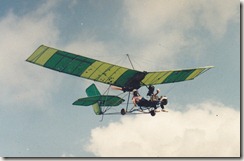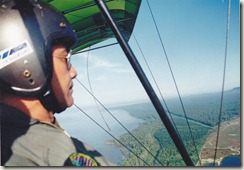By April 1993, David Leong, Rick and myself had switched from flying the ‘Sky-walker’ to a dual-seat micro-light MxII at Tanjong Laboh. I had bought it from Perlis and had it trucked down to us at Batu Pahat. At this stage I have had some 13 hrs of flying and felt confident enough to go solo. I then informed my instructor Mr. Tay about my readiness and he later happily fixed the date of my solo to the 15th of May for early morning which normally would be calm.
On the 14th night, I was high with excitement and tried to retire to bead early but could not sleep. I felt restless, tossing about in bed, even tried counting ‘sheep’ but it did not work. It was probably a long while after midnight that I finally fell asleep. A loud crow from neighbour’s roaster was my morning call; I awoke.and proceeded to the airfield.
I opened the hanger-doors, rolled out my green MxII and indulged in a thorough ‘Pre-flight Checks’; an aviation ritual to ensure safety is complied. The MxII a 2-place, side-by-side seating with the student in the left-seat and the instructor in the right. This micro-light is suitable for beginners; slow and very forgiving which means that if you did a mistake, there would be ample time to correct it. It was designed and built for idiots like me to learn to fly. Only one control-stick shared by the two, student and instructor and has it’s advantage. The instructor can smack off the hands of the student pilot should he fumbles or simply freezes. The maximum speed of the MxII about 45mph and cruising at 36mph. At that time speed was not a concern as we were not going anywhere in a hurry. We were merely enjoying flying around the circuit. Our air-speed indicator was a simple transparent plastic-tube with a spindle inside that has a wheel. there is an inlet at the bottom that channel the air into the tube and pushed the wheel up-wards. You read out the speed on the marked indicator printed on the tube. That morning I did some practices known as ‘crow-hops’ that is you lift off from one end of the runway and puts her down by the other end; just to loosen up the tension before the instructor appeared. When Mr Tay arrived I was ready, my MxII has been top-up with fuel; so I carried out my ‘Pre-flight checks before him. Walking around the micro-light making assessment, eyeing for loose bolts/nuts, cracks, dents on tubes, correct pressure or cuts on tyres and torn fabrics.
Having completed my walk around, Mr Tay was satisfied and we settled down to our seats and buckled-up. I did my cock-pit checks, control stick free movement, fuel-on and observed all clear before starting-up. I shouted out “clear props’ and manually pull the starter-cord just above our heads. The small Rotex engine roared noisily to life. I started to taxi slowly, heading for the runway in use; threshold #33 that means taking-off inland towards the coconut plantation. A final look around to confirm all clear, I pushed the throttle forward and the MxII started to race down gathering speed as it accelerated; in a moment it gathered enough momentum and lifted off the ground. We were airborne!
I held the control stick back for the best angle of climb, remembering Tay’s advise that gaining height is like putting money in the bank. In the event of an emergency you would have sufficient height and time to glide her down safely. I did a left bank into cross-wind, still climbing to circuit level of 200 ft. Another left bank took me to down-wind leg, easing the stick for straight and level flight; flying parallel to the runway.Overflying Jon’s hanger, heading for the cape, a hilly part of land jutting out to sea. The top of the hill is densely forested but the foot barren and rocky. A broken down ‘kelong’ (fishing-hut built on wooden-stake); 2 rows of stakes ‘fork’ out to lure the school of fish into the enclosure where a net is set to trap them.
.
Passing it I bank left again into base-leg heading for the island which is my landmark. We are doing a left-hand circuit which was our standard practice. Yet another left bank which brought us into our ‘final’ leg. The runway in sight, so line-up for the centre-line which is between the boundary red/white/red markers on either side of the runway. I reduce speed to descend gradually, aiming for the threshold #33; Coming in flying low over the oil-palms and by then you realise that the ground rushing pass before you,. So nose up gently and felt the under-carriage wheels touch the ground and roll along. Slowing down and taxing to my left, thus vacating the runway.

MxII ‘open-cock-pit’ (9m-UAE)
When I stopped Tay got out of his seat, gave a tap on my shoulder and beckoned me to go on my own. I was terribly excited as I nodded my head in acknowledgment. I took a deep breath, said a short prayer before shoving the throttle to full power. The tiny Rotex engine screaming angrily in protest as the MxII surged forward forcefully. The ground run became shorter as it was lighter with the absence of my instructor. I was nervous as I realised that the seat next to me empty; means that my guardian angel is not with me. My heart beat kept pounding louder and faster and my fear factor shot up a few notches higher. I began recollect all that was drummed into me by Tay during training; about flight maneevers, effects of control, power-management, and so on. My cross-wind leg was a bit shaky and down-wind even worst; I was trembling and as cold as ice. However I managed to keep ‘straight & level’ flight and parallel.to the runway; meanwhile focus on threshold #33. I had the whole sky to myself as no one else was flying.
Experiencing the exhilarating feelings of open-cock-pit flightTo slow down I bled some power for descending and took her in a graceful glide down into base-leg and into ‘Finals’.The flight path took me over the oil-palms before the runway proper appeared. My aim-point to touch down at the threshold. And the same sensation engulfed me, the ground rushing before me injecting fear into my system. Keeping calm, steady, steady, level up for the flare, that is nose-up, bled off a bit more power and the main under-carriage touched mother-earth with a slight bump. As she rolled out I immediately vacated the runway by pulling her aside. And as the engine coughed out to a stop, the was silence and a great sense of relief overcame me. For a moment I just sat there motionlessly and looking dumb; almost un-believable, I had done it. It had been a wonderful experience, filled with excitement, with fright, joy, a day to remember. My long waited childhood dreams of flying have been fulfilled and there was this complete sense of achievement and satisfaction within..






